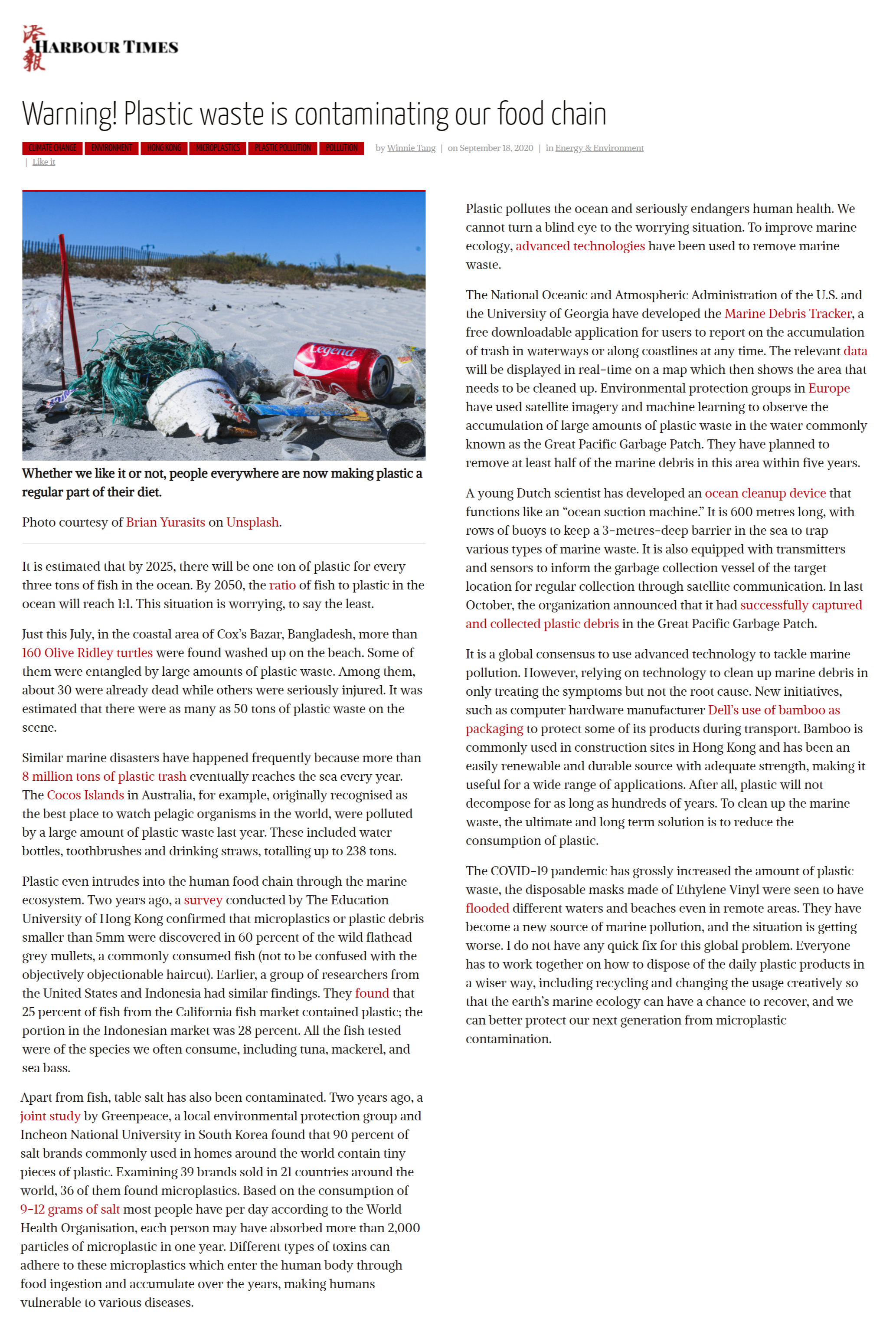網上版請按此

Warning! Plastic waste is contaminating our food chain
It is estimated that by 2025, there will be one ton of plastic for every three tons of fish in the ocean. By 2050, the ratio of fish to plastic in the ocean will reach 1:1. This situation is worrying, to say the least.
Just this July, in the coastal area of Cox's Bazar, Bangladesh, more than 160 Olive Ridley turtles were found washed up on the beach. Some of them were entangled by large amounts of plastic waste. Among them, about 30 were already dead while others were seriously injured. It was estimated that there were as many as 50 tons of plastic waste on the scene.
Similar marine disasters have happened frequently because more than 8 million tons of plastic trash eventually reaches the sea every year. The Cocos Islands in Australia, for example, originally recognised as the best place to watch pelagic organisms in the world, were polluted by a large amount of plastic waste last year. These included water bottles, toothbrushes and drinking straws, totalling up to 238 tons.
Plastic even intrudes into the human food chain through the marine ecosystem. Two years ago, a survey conducted by The Education University of Hong Kong confirmed that microplastics or plastic debris smaller than 5mm were discovered in 60 percent of the wild flathead grey mullets, a commonly consumed fish (not to be confused with the objectively objectionable haircut). Earlier, a group of researchers from the United States and Indonesia had similar findings. They found that 25 percent of fish from the California fish market contained plastic; the portion in the Indonesian market was 28 percent. All the fish tested were of the species we often consume, including tuna, mackerel, and sea bass.
Apart from fish, table salt has also been contaminated. Two years ago, a joint study by Greenpeace, a local environmental protection group and Incheon National University in South Korea found that 90 percent of salt brands commonly used in homes around the world contain tiny pieces of plastic. Examining 39 brands sold in 21 countries around the world, 36 of them found microplastics. Based on the consumption of 9-12 grams of salt most people have per day according to the World Health Organisation, each person may have absorbed more than 2,000 particles of microplastic in one year. Different types of toxins can adhere to these microplastics which enter the human body through food ingestion and accumulate over the years, making humans vulnerable to various diseases.
Plastic pollutes the ocean and seriously endangers human health. We cannot turn a blind eye to the worrying situation. To improve marine ecology, advanced technologies have been used to remove marine waste.
The National Oceanic and Atmospheric Administration of the U.S. and the University of Georgia have developed the Marine Debris Tracker, a free downloadable application for users to report on the accumulation of trash in waterways or along coastlines at any time. The relevant data will be displayed in real-time on a map which then shows the area that needs to be cleaned up. Environmental protection groups in Europe have used satellite imagery and machine learning to observe the accumulation of large amounts of plastic waste in the water commonly known as the Great Pacific Garbage Patch. They have planned to remove at least half of the marine debris in this area within five years.
A young Dutch scientist has developed an ocean cleanup device that functions like an “ocean suction machine.” It is 600 metres long, with rows of buoys to keep a 3-metres-deep barrier in the sea to trap various types of marine waste. It is also equipped with transmitters and sensors to inform the garbage collection vessel of the target location for regular collection through satellite communication. In last October, the organization announced that it had successfully captured and collected plastic debris in the Great Pacific Garbage Patch.
It is a global consensus to use advanced technology to tackle marine pollution. However, relying on technology to clean up marine debris in only treating the symptoms but not the root cause. New initiatives, such as computer hardware manufacturer Dell's use of bamboo as packaging to protect some of its products during transport. Bamboo is commonly used in construction sites in Hong Kong and has been an easily renewable and durable source with adequate strength, making it useful for a wide range of applications. After all, plastic will not decompose for as long as hundreds of years. To clean up the marine waste, the ultimate and long term solution is to reduce the consumption of plastic.
The COVID-19 pandemic has grossly increased the amount of plastic waste, the disposable masks made of Ethylene Vinyl were seen to have flooded different waters and beaches even in remote areas. They have become a new source of marine pollution, and the situation is getting worse. I do not have any quick fix for this global problem. Everyone has to work together on how to dispose of the daily plastic products in a wiser way, including recycling and changing the usage creatively so that the earth's marine ecology can have a chance to recover, and we can better protect our next generation from microplastic contamination.
Dr. Winnie Tang
Adjunct Professor, Department of Geography, Faculty of Social Sciences and Faculty of Architecture, The University of Hong Kong